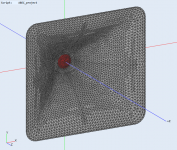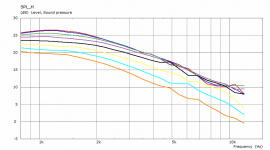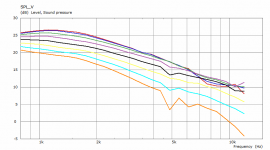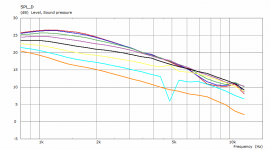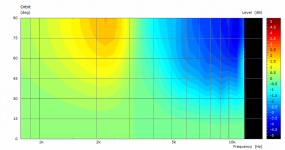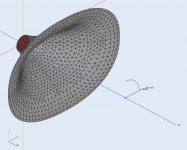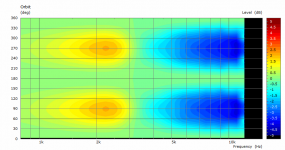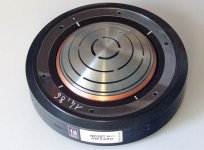Yeah the diagonals seem to be better than horizontal very often 😀 Maybe there is an anomaly? Abec determines the diagonal by some algorithm? How about parameters that result 5 or 8 corners so there would be "diagonal" shape at the horizontal plane?
P.S.
Here is another one study by Dr. Alexandr Voishvillo experimentally confirming subharmonics in CD
Dual Diaphragm Compression Drivers
It appears that the sub-harmonics are relevant only in some cases at higher SPL levels. But generally contributions of sub-harmonics shouldn't be significant compared with THD and IMD.

Here is another one study by Dr. Alexandr Voishvillo experimentally confirming subharmonics in CD
Dual Diaphragm Compression Drivers
It appears that the sub-harmonics are relevant only in some cases at higher SPL levels. But generally contributions of sub-harmonics shouldn't be significant compared with THD and IMD.

As far as I know it really makes no difference in ABEC whether it is horizonal, diagonal or whatever - these are just data from SPL probes placed at will.Yeah the diagonals seem to be better than horizontal very often 😀 Maybe there is an anomaly? Abec determines the diagonal by some algorithm? How about parameters that result 5 or 8 corners so there would be "diagonal" shape at the horizontal plane?
- This is from the last example but for a slightly more "conventional" shape (still thinking about using a compression driver via the open back side).
Attachments
Last edited:
I know atleast 3 diefferent experimental studies of sub-harmonics in compression drivers
P.S.
Here is another one study by Dr. Alexandr Voishvillo experimentally confirming subharmonics in CD
Dual Diaphragm Compression Drivers
It appears that the sub-harmonics are relevant only in some cases at higher SPL levels. But generally contributions of sub-harmonics shouldn't be significant compared with THD and IMD.
I never said that sub-harmonics don't exist, just that they are not significant to the point of needing resolution. Nothing in any of what you have linked has changed my mind on that. In several studies of CDs with real music the perception of nonlinearity was not found to be significant even when the driver had 25% THD. As an academic study it is interesting, but as something whose correction would make an audible difference I remain unconvinced.
Jack Oclee-Brown in his mentions one of your patents but also states that it is wrong 🙂 (page 114)
Honestly, I don't know for sure what he means but maybe you could spare a few words (?). Or do I read it wrong?
He says that it is wrong because I didn't understand the function of the compression chamber and something about using the Wendt and Thuras approach, which I didn't use. I do understand the role of the compression chamber and have many more years of research into CDs that the author. Sorry, I simply don't accept his claim.
I never said that sub-harmonics don't exist, just that they are not significant to the point of needing resolution. Nothing in any of what you have linked has changed my mind on that. In several studies of CDs with real music the perception of nonlinearity was not found to be significant even when the driver had 25% THD. As an academic study it is interesting, but as something whose correction would make an audible difference I remain unconvinced.
I also never said that you said that sub-harmonics doesn't exist 😀.
E.C. Wente and A.L Thuras - A High-Efficiency Receiver for a Horn-Type Loudspeaker of Large Power capacity (Bell System Technical Journal, 1928)
Part I:
Part I:
Attachments
Last edited:
E. C. WENTE. 2,037,187. SOUND TRANSLATING DEVICE. Filed March 28, 1933.
The godfather of all modern compression drivers.
The godfather of all modern compression drivers.
Attachments
-
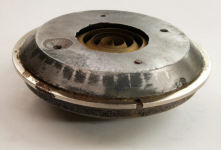 594A_Plug II.png570.2 KB · Views: 154
594A_Plug II.png570.2 KB · Views: 154 -
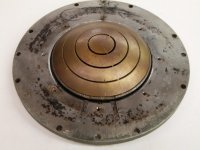 594A_Plug.jpg408.6 KB · Views: 305
594A_Plug.jpg408.6 KB · Views: 305 -
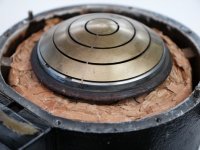 594A_Plug&Magnet.jpg478.5 KB · Views: 308
594A_Plug&Magnet.jpg478.5 KB · Views: 308 -
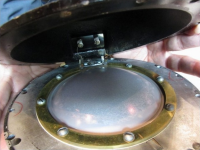 594A_Diaphragm.png838.3 KB · Views: 318
594A_Diaphragm.png838.3 KB · Views: 318 -
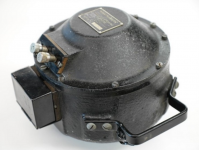 594A_Full.png510.3 KB · Views: 318
594A_Full.png510.3 KB · Views: 318 -
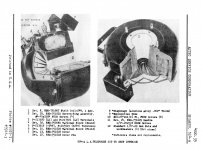 594A from ERPI_Small_Angled.jpg933.1 KB · Views: 340
594A from ERPI_Small_Angled.jpg933.1 KB · Views: 340 -
Bell_Labs&Wente_Comp_Driver.pdf494 KB · Views: 118
-
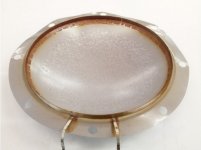 594A_Diaphragm Rear.jpg340.4 KB · Views: 131
594A_Diaphragm Rear.jpg340.4 KB · Views: 131 -
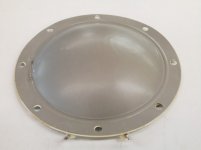 594A_Diaphragm Front.jpg277.2 KB · Views: 135
594A_Diaphragm Front.jpg277.2 KB · Views: 135
Last edited:
Not much has changed since then, heh? 🙂
- Would the orbit presentation as a polar map made more sense?
This is an example going from 0 to 90 deg anti-clockwise, normalized to zero deg.
- Would the orbit presentation as a polar map made more sense?
This is an example going from 0 to 90 deg anti-clockwise, normalized to zero deg.
Attachments
Last edited:
At least I have never encounter sub-harmonics at SPL usual for most domestic loudspeaker.
As for the phd thesis of Jack Oclee-Brown I suppose that his main "claim" to the Earl Geddes phase plugs design was that Fresnel zones approach introduced by Earl doesn't ensure equal pressure distribution in the the phase plug channels above the first cavity mode of the compression chamber. Whereas the Smith design approach enable to get equal pressure distribution in the channels at higher frequencies. But, as I understand the Geddes design approach, it enables one to get constant phase volume velocity distribution below the first cavity mode, whereas the Smith design approach does it not. So, what is more important, it is a matter for debate.
As for the phd thesis of Jack Oclee-Brown I suppose that his main "claim" to the Earl Geddes phase plugs design was that Fresnel zones approach introduced by Earl doesn't ensure equal pressure distribution in the the phase plug channels above the first cavity mode of the compression chamber. Whereas the Smith design approach enable to get equal pressure distribution in the channels at higher frequencies. But, as I understand the Geddes design approach, it enables one to get constant phase volume velocity distribution below the first cavity mode, whereas the Smith design approach does it not. So, what is more important, it is a matter for debate.
Could be the full circle. Not sure about the readability.
Looks like 2 sources 😉
Last edited:
At least I have never encounter sub-harmonics at SPL usual for most domestic loudspeaker.
As for the phd thesis of Jack Oclee-Brown I suppose that his main "claim" to the Earl Geddes phase plugs design was that Fresnel zones approach introduced by Earl doesn't ensure equal pressure distribution in the the phase plug channels above the first cavity mode of the compression chamber. Whereas the Smith design approach enable to get equal pressure distribution in the channels at higher frequencies. But, as I understand the Geddes design approach, it enables one to get constant phase volume velocity distribution below the first cavity mode, whereas the Smith design approach does it not. So, what is more important, it is a matter for debate.
Simulate both?
Yes it is. I wanted to wait for the polar plot where it is more clearly visible (see the one above). This is also one of the arguments for (a more) axisymmetric device.Is that pattern flip in the orbit 30deg image around 3khz, where the lines flip order?
Attached is the complete ABEC project.ps. could you share abec simulation related setting of the 16"+ waveguide you posted recently? I'm getting errors if I try to simulate bigger ones as I posted in this thread some time ago. Thanks!
Attachments
Last edited:
I am not sure whether this applies:
"The acoustic resonant modes and the main fluid dynamic instability are sufficiently apart in frequency not to strongly interact with one another."
To finish the history lesson:
"Around 1954, the Altec Service Co. NY, City, sold 594-A for $69.00 with original blue/gray diaphragm which is the most perfect sounding driver. RCA 1930's Photophone HF horns provide full acoustic loading down to 150 Hz which is essential for Zero Horn Honk performance with cross over in the region of 250 to 300 Hz. JBL also manufactured simliar horns.
For what it's worth, a two way theater horn system delivers a huge wave front with excellent uniform frequency response every where in a well designed listening room with 10 watts or less of amplifier power__Single Ended amps, Anyone? The movie theaters prior to the 1950's were capable of magnificent concert hall acoustics with room sound reverberation quality.
The JBL model 2440 is the professional version of JBL permanent magnet model 375 driver. Both of these 594-A clones with identical original JBL Aluminum diaphragms come very close to 594-A.
The actual measurements of 594-A with the blue/grey diaphragm are dead flat up to the mass break point around 7,000Hz with a roll off at 6 db / octave plus or minus 0.1 db all the way to 20,000 Hz.
You can tip up the response 6 db / octave above 7,000 Hz with one RC in the amplifier to provide flat response to 20,000 hz. Performance of 594-A with the "repair" softer "Cream color" aluminum diaphragm come close; however nothing sounds as clean and real as the orignal blue grey version.
The blue /grey diaphragm color which looks like it "just clawed its way out of hell" is due to the Western Electric heat treatment resulting in extreme hardness of the special duraluminum alloy no longer available unless you put up $100,000 up front for production startup."
"The acoustic resonant modes and the main fluid dynamic instability are sufficiently apart in frequency not to strongly interact with one another."
To finish the history lesson:
"Around 1954, the Altec Service Co. NY, City, sold 594-A for $69.00 with original blue/gray diaphragm which is the most perfect sounding driver. RCA 1930's Photophone HF horns provide full acoustic loading down to 150 Hz which is essential for Zero Horn Honk performance with cross over in the region of 250 to 300 Hz. JBL also manufactured simliar horns.
For what it's worth, a two way theater horn system delivers a huge wave front with excellent uniform frequency response every where in a well designed listening room with 10 watts or less of amplifier power__Single Ended amps, Anyone? The movie theaters prior to the 1950's were capable of magnificent concert hall acoustics with room sound reverberation quality.
The JBL model 2440 is the professional version of JBL permanent magnet model 375 driver. Both of these 594-A clones with identical original JBL Aluminum diaphragms come very close to 594-A.
The actual measurements of 594-A with the blue/grey diaphragm are dead flat up to the mass break point around 7,000Hz with a roll off at 6 db / octave plus or minus 0.1 db all the way to 20,000 Hz.
You can tip up the response 6 db / octave above 7,000 Hz with one RC in the amplifier to provide flat response to 20,000 hz. Performance of 594-A with the "repair" softer "Cream color" aluminum diaphragm come close; however nothing sounds as clean and real as the orignal blue grey version.
The blue /grey diaphragm color which looks like it "just clawed its way out of hell" is due to the Western Electric heat treatment resulting in extreme hardness of the special duraluminum alloy no longer available unless you put up $100,000 up front for production startup."
- Home
- Loudspeakers
- Multi-Way
- Acoustic Horn Design – The Easy Way (Ath4)
